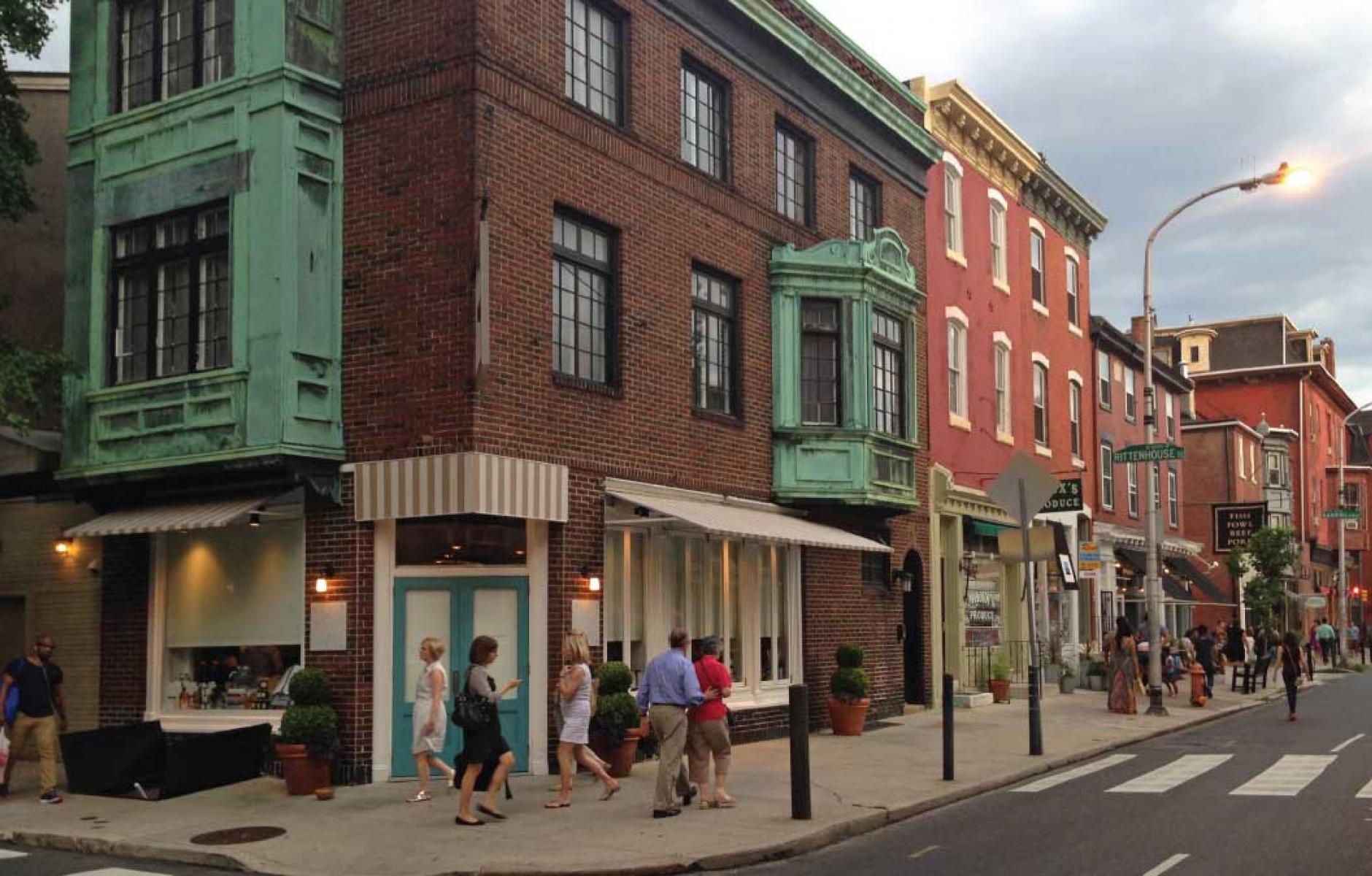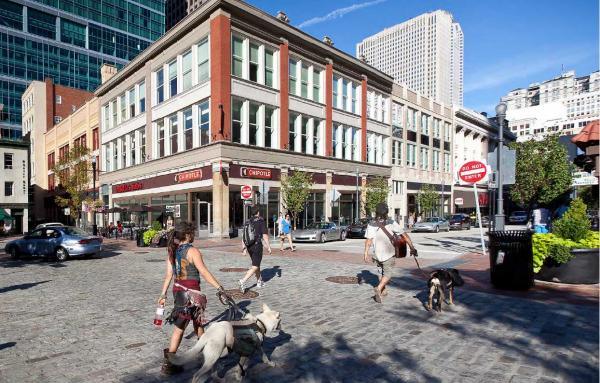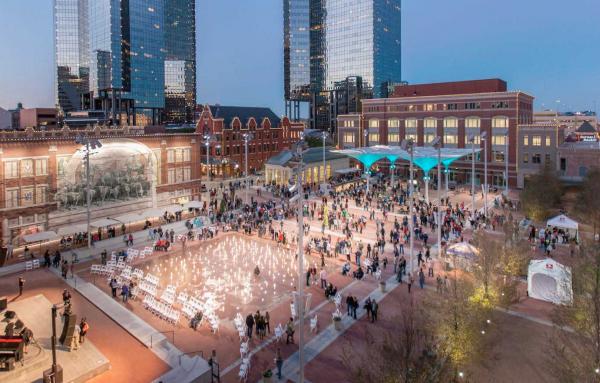
Traditional cities are having a big decade
Traditional American cities like Seattle, New Orleans, New York City, and Philadelphia are growing this decade at a rate that they haven’t seen since the 1940s, according to a Public Square analysis. The 25 largest traditional cities gained 3.8 percent in population in the first half of this decade, from 2010 to 2015, according to US Census Bureau estimates.
Traditional cities lost population in all of the previous six decades except the 1990s, and New York City is responsible for a modest gain in that decade. Currently these cities are experiencing broad growth in the form of infill and redevelopment. In the 1940s, when traditional cities grew by 8.4 percent, they still had greenfields to develop. There is no more room to extend street grids in these cities, except on special parcels like former military bases, airports, or industrial sites.
While traditional cities can be found in nearly every region of the US, they are concentrated in the Northeast and Upper Midwest. Their growth and economic health is a positive sign for these cities and the nation as a whole.
The five fastest-growing traditional cities are New Orleans, Seattle, Washington DC, Boston, and Richmond VA. A half dozen traditional cities continue to lose population, notably Detroit. But Detroit’s population loss slowed in 2015 to the lowest level in decades and may show an increase next year.

What are traditional cities?
Public Square defined traditional cities by comparing city population in 2010 with 1950—the mid-century inflection point for American urbanism. Cities that had a population in 1950 of at least 75 percent of the 2010 population—and did not greatly expand their boundaries in this period—are defined as “traditional cities.”
Traditional cities are centers of finance, innovation, business, arts, and culture. They are important to the nation’s history and sense of place. When foreigners visit the US and Americans go on vacation, they frequently go to traditional cities—which are the locus of 7 of the 10 most visited US tourist attractions.
Physical form
Traditional cities are built largely on pre-1950 connected street grids with small blocks. They are more compact and walkable, and have better public transportation, than more recently built US cities. The differences in walkability and transit reduce household transportation expenditures and improve opportunities for exercise in the form of walking and bicycling.
The six decades between 1950 and 2010 were dominated by conventional suburban development, also known as drive-only sprawl. Cities and suburbs built in this era are largely characterized by subdivisions, shopping centers, office parks, and automobile-oriented thoroughfares. This newer form of cities has a profound impacted on modern life, and trends like New Urbanism and smart growth are a reaction to that impact. Market demand, particularly among young adults, is moving toward seeking the qualities found in traditional cities like walkability and historic urban fabric. Many analyses of cities fail to isolate the affect of urban form. That’s why focusing on traditional cities, relative to other kinds of cities, is important.

The average Walk Score of traditional cities is 78—nearly double that of more sprawling cities. Traditional cities average 85 square miles each and house more than 10,480 people per square mile. About 45 percent of residents get to work by transit, walking, or bicycling, which is 7.5 times the rate of sprawling cities. The top 25 traditional cities have an estimated population of 22.15 million, or 7 percent of the US total.
History
These cities peaked, as a whole, in the middle of the last century, and began to bleed residents in the 1950s and 1960s as the suburbs grew. That outward flow became a flood in the 1970s when every one of these cities shrank and the group contracted by a whopping 13 percent. These cities suffered a net loss of 3.2 million residents in the 1970s. The exodus slowed in the 1980s, and then the 1990s this group rebounded, with a 2.3 percent gain for the decade.
A closer look, however, reveals that this growth was due entirely to New York City, which experienced explosive growth in that decade. The other 24 cities, as a group, continued to shrink even though some, like Chicago and San Francisco, gained population along with the Big Apple. In the 2000s, New York City’s growth slowed due to the September 11 attacks. Also, Detroit and New Orleans crashed—the latter due to Hurricane Katrina. Traditional cities lost nearly a half million people in the 2000s and ended the decade right where they were in 1990. But the 1990s and 2000s laid the groundwork for the current broad recovery. In those two decades every traditional city on the list experienced downtown revitalization and the recovery of adjacent neighborhoods, although in the case of some cities like Detroit, this trend was just beginning.
Sprawling cities
Public Square also created a list of the 25 largest sprawling cities, identified by having a 1950 population that was less than half of the 2010 population. The sprawling cities consist mostly of post-1950 suburban streets networks, characterized by cul-de-sacs and automobile-oriented arterial roads and large blocks. Sprawling cities average about 300 square miles each, which is 3.5 times bigger than the traditional cities. Their borders have expanded tremendously. Density in the sprawling cities is about 2,750 people per square mile—just over a quarter that of traditional cities. Walk Score is 40, which is highly automobile dependent.
Sprawling cities are growing at more than double the rate of traditional cities and the nation as a whole. One reason for that growth is that sprawling cities, with one or two exceptions, are located in the Sunbelt—the fastest growing US region. Also, these cities can grow in every direction. They are building infill, revitalizing downtowns, and developing near transit stations—but they also have plenty of greenfields available for housing subdivisions.
The sprawling cities have their traditional parts—the downtowns and adjacent neighborhoods of cities like Houston, Indianapolis, Albuquerque, and Savannah, Georgia. The latter city, at 103 square miles, is bigger and more spread out than is widely recognized. But the one square mile of 22 historic squares that is the setting of Forest Gump and Midnight in the Garden of Good and Evil projects the image of Savannah to the world. Similarly, visitors to sprawling San Antonio typically see the Riverwalk, The Alamo and the rest of downtown, and nearby revitalized neighborhoods. Tucson is known for adobe buildings in the oldest part of town. A streetcar through Tucson’s pre-1950 core has recently spurred a billion dollars in new development.
The health of traditional city centers is important to the economy and culture of nearly every region in America—even the most sprawling metros.
Gentrification
Concern over gentrification is high, especially in cities experiencing the highest economic growth and connected to the global economy. The poster child for gentrification is San Francisco, which is attracting wealthy tech entrepreneurs and professionals, many of whom work in nearby Silicon Valley. The City by the Bay has the highest rents in the nation.
Many traditional cities are seeing high pressure on real estate prices as new housing has trouble keeping up with demand. Ten of the 25 traditional cities are on track for double-digit growth for the decade. One of these cities is Minneapolis, which has gained 7.4 percent in population so far this decade, following stagnant growth in the 2000s. A recent article on Minnpost.com reports how that city is struggling with retaining neighborhood character in the face of higher density and growth pressure.
Reports Minnpost: “The North Loop was long considered especially receptive to development. New residential and commercial projects rarely displaced current tenants. Instead, historic buildings were repurposed and vacant lots were filled. And redevelopment delivered exactly the amenities that growth and density advocates said it would: more restaurants, more bars, more retail, more people on the street. … But over the last year, three projects in the neighborhood have drawn opposition.”
Many traditional cities have de-gentrified much more than gentrified. Buffalo has lost 56 percent of its people since 1950. The city is still losing population this decade—although the outward flow is reduced to a trickle and downtown is lively again. The Queen City has a small handful of neighborhoods that have gentrified—and scores that suffer from disinvestment. Buffalo’s greatest asset today may be cheap rents combined with historic buildings and neighborhoods that are coveted by a market that has rediscovered the charms to traditional cities.
Given current trends, it is a matter of time before cities like Buffalo grow again. Some are likely to gain population this decade. Detroit, which has fallen further than any traditional city except St. Louis, is seeing a massive investment in its core—led by billionaire Dan Gilbert.
Freeway removal
Although traditional cities are leading population centers today, they were more so in the middle of the 20th Century. When freeways were built through cities, tearing down urban fabric, these cities suffered tremendously—and their citizens fought many of the biggest mid-20th Century freeway battles.
Traditional cities have also been leaders in removing unnecessary grade-separated highways. Two freeway spurs, damaged by earthquakes, have been successfully removed in San Francisco, bringing back neighborhoods, restoring housing, and spurring economic growth. In New York City, a section of the West Side Highway collapsed in 1973, and it was eventually torn down and converted to a surface boulevard. The highway has never been missed. Milwaukee was the first US city to voluntarily tear down a section of freeway, a decision that has spurred investment downtown. Now, as many urban freeways are reaching the end of their functional lives, removal is gaining momentum, especially in traditional cities.
Replacement with surface streets saves money compared to reconstruction of grade-separated highways. Rochester, the smallest city on this list, recently filled in a section of its sunken “Inner Loop,” a 1960s highway that ringed downtown like a noose. Following the construction of that highway and urban renewal projects, Rochester’s downtown lost 85 percent of its people. Now its downtown is surging back and is expected to regain most of its lost population by the end of this decade.
The big question is: Will this growth continue? The 1940s, a strong decade for traditional cities, was followed by six decades of decline. Although gentrification is a significant problem, it is better than another half century of disinvestment—which would kill many of these cities. But the strong momentum of growth along with rising demand for walkable neighborhoods this decade indicates traditional cities will remain on an upward swing for the foreseeable future.







